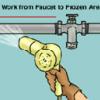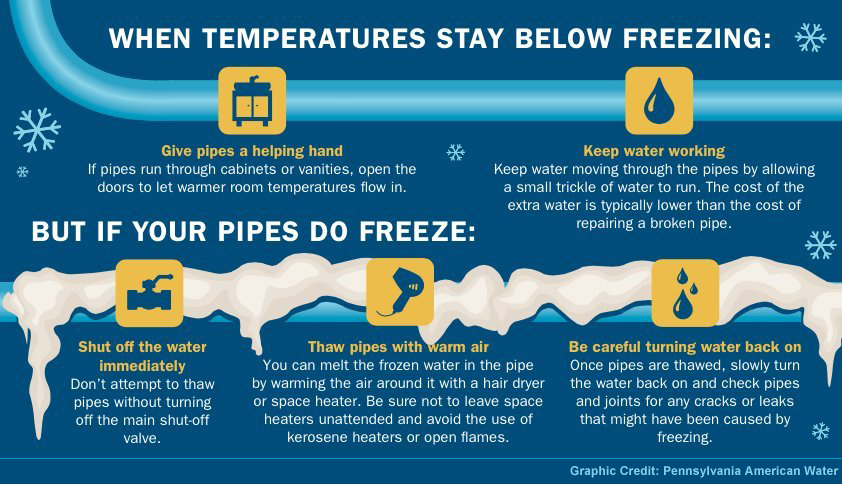Winterization and Tips on Prevention of Winter Damage
Employees in our water department have put together a checklist to help you prepare your home for winter. While each home will have individual needs, use this list as a quick review. Download a copy of the winterization checklist.
Make sure your home has a main water shut off valve that is easily accessible to you. District ordinance requires this. If your home doesn’t currently have a shut off valve, the District will waive the water turn on/turn off fee during normal business hours to allow for it to be installed.
PLEASE NOTE! If a water main project was completed on your street since 2004, and a new meter box and service connection was installed to your property, it is likely a customer side shut off valve was installed just outside of the property side of the meter box. Please contact the District for more information if you are in the following areas: Beaver Street, Plaza Circle, Cutthroat Ave, Dolly Varden Ave, Loch Levon Ave, Steelhead Ave, Chipmunk Ave, Carnelian Bay, and the Kingswood area.
Always turn off the water to your home whenever you will be gone for any length of time. In the event of broken pipes, a broken toilet seal, or other water emergencies, this can save you thousands of dollars in water bills and damage to your home.
How to Help Prevent Water Damage to Your Property
Don’t wait for an emergency. Always know how to shut off the water supply to your entire house, or parts of it. Knowing the location of a simple shut-off valve could save thousands of dollars in damage. Everyone in your house should know where the valves are located and the direction they need to be turned to stop the flow.

The main shut-off valve is usually found on the side of your house where the water comes in from the water meter. Commonly this would be in the garage, basement, or crawl space just inside the foundation, often near the front faucet. It’s called a gate valve and most types look like a wheel. Putting a few drops of household oil on the handle threads annually will help keep it from corroding and to assure it will turn in case of an emergency.
In many of the condominiums the main shut-off valve for an individual unit may be located in a bathroom or pantry. The association’s maintenance personnel should be able to show you your unit’s location.
Most fixtures such as water heaters, dishwashers, sinks and toilets, have individual shut-off valves on the water lines leading to a fixture. If a problem occurs, you can turn the water supply off and still have water to the rest of the house. You’d be surprised to know how many people don’t think of this.
Before a problem arises, be sure you have a main shut-off valve. Occasionally older homes have no way to shut off the water; it’s rare, but possible. Contact a plumber to have a gate valve installed. They’re easier to find, faster to use and require no tools. In an emergency these are all important features.

So remember, when an emergency arises, the first rule is to stop the flow of water before it can do serious damage to your residence and/or business, as well as your belongings.
Winterization
Every year many of our customers find themselves without water because of frozen water pipes. Even though you can never anticipate how severe winter might be, there are some steps you can take now to avoid problems this winter.
Yard Irrigation
For underground irrigation systems:
- Turn off the water to the irrigation system at main valve
- Set the automatic irrigation controller to the “rain” setting, which shuts off the signal to the valves
- Turn off each of the valves to release pressure in the pipes
- Drain all of the water out of any irrigation components that might freeze and either suck out any remaining water with a wet/dry shop vacuum or blow it out using an air compressor (professional help is recommended)
- Insulate any exposed pipes
For above-ground irrigation systems:
- Turn off outdoor faucets and disconnect garden hoses
- If practical, use an indoor valve to shut off and drain water from pipes leading to outside faucets
- Insulate outside faucets with a Styrofoam cover, rags or paper
- Disconnect garden hoses from “frost-free” hose bibs
Around The House
Disconnect and drain outdoor hoses. Disconnecting the hose allows water to drain from the supply line, preventing an overnight freeze from bursting either the faucet or the supply line piping.
Cover air vents. Be sure to close or cover the air vents located in the foundation wall of your home. This will help prevent the pipes in the crawl spaces from being exposed to freezing air.
Opening cabinet doors will allow heat to get to uninsulated pipes under sinks and appliances near exterior walls.
Insulate pipes or faucets in unheated areas. Be aware that the hot water pipes generally freeze before pipes that carry cold water. Pipes that tend to be most susceptible to freezing are those found in the outer walls, in crawl spaces, the attic, or the garage. Exposed pipes should be insulated with items such as pipe wrap, heat tape, and foam jackets. These types of insulating products are available at local building supply stores or hardware stores. Be sure to follow the manufacturer’s instructions carefully to install these products. An alternative to tape or cable is wrapping pipes with several layers of newspaper. If you still have questions, call a plumber for help.
Winterize your vacant house. If you leave your house for several days, take the following steps to help protect pipes from freezing:
- Turn off main shut-off valve. Be aware that if you have a fire protection sprinkler system in your house, it will be deactivated when you shut off the water.
- Turn off water heater. (If you drain your hot water heater be sure that you also turn off the electricity or gas source to this unit.)
- Open indoor and outdoor faucets to drain pipes.
- Drain toilets by holding down the lever until the tank empties and pour biodegradable antifreeze into sinks and toilets. Biodegradable anti-freeze is what is used to winterize RV’s and is available anywhere that sells RV supplies.
- Leave your heat on at a minimum temperature of 55 degrees to help keep pipes from freezing in interior walls.
If your pipes freeze don’t take chances. If you turn on your faucets and nothing comes out, leave the faucets turned on and call a plumber. If you detect that your water pipes have frozen and burst, turn off the water at the main shut-off valve in the house; leave the water faucets turned on.

CAUTION: Never try to thaw a pipe with a torch or other open flame. Even the most cautious homeowner may sooner or later experience a frozen pipe. If this happens to you, don’t panic. A freeze up at an exposed pipe or under a sink generally can be eliminated by applying heat with a hair dryer, heat lamp or even a light bulb. Light bulbs should always be protected by a cage (trouble light type) and not to be placed near flammable materials. Start by warming the pipe as close to the faucet as possible, working toward the coldest section of pipe. Some homeowners have been known to use a flame or gas torch when thawing pipes. Although this may seem to be a reasonable approach, it is one of the most dangerous. Attempting to thaw a line too rapidly with extreme heat could result in an explosion and may cause injury. Water damage is preferable to burning down your house.
Get to know your plumbing. Learn how to shut the water off and know where your pipes are located. If your pipes do freeze, time is of the essence. The quicker you can shut off the water, or direct your plumber to the problem, the better chance you have to prevent pipes from bursting.

As a final note, please contact the District and make sure that your emergency contact information is complete and updated. If the District or a neighbor detects a leak or running water on your property, then staff can contact you regarding the problem.
District Turn Off for Winter
Property owners that do not have a shut off valve and do not intend to utilize their home in the winter, may contact the District to have the water shut off for the winter.
- The turn on and turn off, must be scheduled at least 24 hours in advance of the requested service.
- If scheduled during regular business hours, the cost is $60 to turn the water off and $60 to turn the water on. If the request is after business hours, the cost is $150.
- Turning the water off does NOT insure that the pipes will not freeze! It is also recommended that the property owner open the faucet and/or hose bibs in multiple spots, but if the plumbing is not set up to drain, it is possible there could still be frozen and broken pipes.
- The property owner, or their designee, must be present for the water turn on in the Spring in case of frozen/broken pipes.
- The District will not clear the meter box in order to turn the water back on in the Spring. It is the property owner’s responsibility to ensure the meter box is accessible before scheduling to have the water turned back on.
- Properties with their water turned off will continue to received a water and sewer bill.


